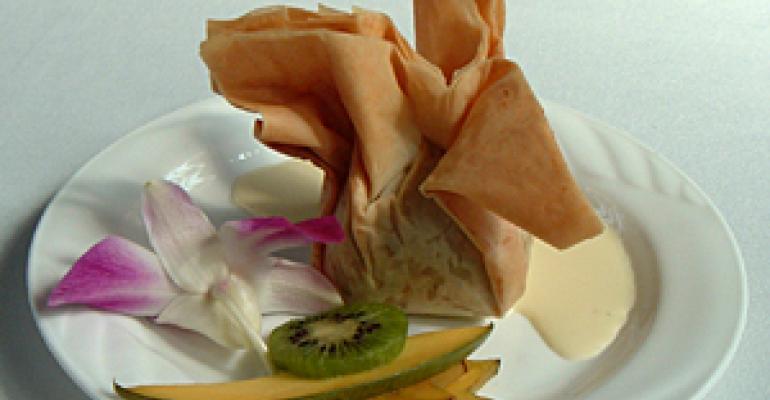Who said food trends had to end with the entrée? Certainly not the growing number of chefs and restaurateurs who are tweaking their dessert selections to reflect the currents evident elsewhere on the menu.
Mindful of the need to coax a few more dollars from the customers they manage to draw, operators are giving their after-meal treats a splash of the hot trends that are helping to sell entrées, sides and appetizers — ultra-fresh local ingredients, identified by their source, or comfort foods updated with a decidedly high-art twist. Fresh herbs and aromatics are being mixed into crusts or other baked components, and even a few concessions to health are figuring into the indulgences.
“You might see things like a crème brûlée with a ginseng crust,” says Dean Small of Synergy Consulting Group, a Laguna Niguel, Calif.-based consulting firm that specializes in menu development and operational efficiencies.
Decadence is still the rule, Small observes, but new economic realities are shaking dessert preconceptions.
“Desserts tend to be more traditional. At the end of the day, people are looking for an indulgence,” he comments. “But today operators are looking at it differently, because they have fewer butts in the seats. They need to build the check average in a responsible way. The challenge is, how do you play on a quality experience so [guests] will order dessert and still feel they’re getting a value? You have to really wow them, to really give them something special.” Giving them the pizzazz of the latest food fashions is one way to do it.
So, he says, “chocolate is still king. But now maybe it’s a Tahitian chocolate, from a particular farm in Tahiti. Sourcing information is very important.”
Indeed, a Tahitian vanilla ice cream recently was featured on the tasting menu of Vie in Chicago, atop an apple spice pound-cake pudding. New on the regular menu is Wisconsin maple pudding cake, a nod to the state next door.
Others contend that no listed source is more appreciated than the term “local.” The National Restaurant Association cited the use of local produce in restaurants as the industry’s hottest trend this year, based on a survey of 1,600 chefs. Clearly the current isn’t bypassing desserts.
Robert Harbison, executive chef of Princeton University Dining Services, features a Local Raspberry Chocolate Cigar, or a cigar-like cylinder made by rolling leftover chocolate bread pudding around fresh raspberries. “Plucked the fruit myself down the road,” he boasts.
He also uses sorbet from an ice creamery in Princeton, The Bent Spoon, and is looking forward to recreating a tart next fall that’s made with apples from the area’s Terhune Orchards.
Harbison is a big believer in the use of aromatics, which he says the Princeton students tend to prefer over sauces. His local apple tart, for instance, is sometimes made with thyme in the crust. In other instances, he steeps the apples in thyme simple syrup, and in others, he makes a “thyme nest” into which the tart is placed before being slipped into a 350-degree oven, to bring out the scent.
He’s also done the same thing with lavender used as the nest, and as a beggar’s purse instead of a tart, he says.
The Publican, the new Chicago hotspot affiliated with the renowned chef Paul Kahan, similarly features lemon pound cake served with yogurt and thyme.
The NRA’s chef survey indicated they may not be alone in incorporating savory elements into desserts. Savory desserts ranked No. 5 on the list of dessert trends.
The fellow traveler of “local” appears to be “seasonal,” as indicated by the exponential increase this month of restaurant desserts incorporating the staples of springtime treats: strawberries and rhubarb.
Often blended into the selections are artful updates of old favorites. Alan Carter, pastry chef and co-owner of Mission Beach Café in San Francisco, is planning to showcase Strawberry Rhubarb Pie as the berries come into season. Instead of featuring strawberry shortcake, he’s offering up a Strawberry Mousse Cake, along with a Roasted Strawberry and Almond Tart.
NAHA, an upscale restaurant in Chicago, is featuring “early spring rhubarb” in one of its new desserts. The tart red vegetable is part of a parfait that also incorporates buttermilk panna cotta, lime granita, white chocolate, almond grissini, or bread sticks, and espuma, or foam.
Herbs and aromatics are likely to show up in more desserts, Small says, but “it’ll be a slow-growth. If you put a bunch of people in a room and said, ‘How would you like something lavender-flavored for dessert?’, I don’t think they’d be cheering. ”
He’s far more bullish on the health halo that herbs and other ingredients might bestow on an indulgence — “things like Ginko biloba, or nutraceuticals, things that are perceived as being healthy for you, combined with something decadent. People still are going to want that indulgence.”




